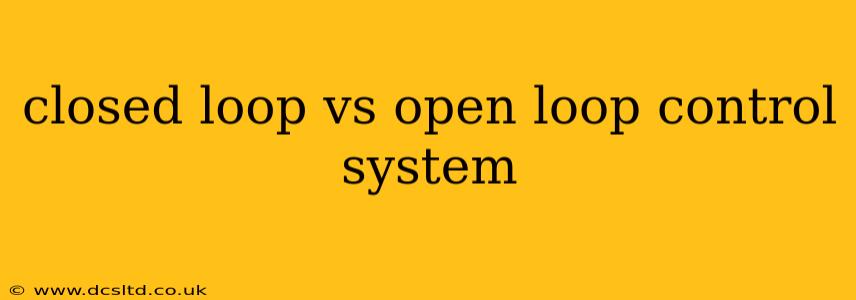Control systems are the backbone of countless modern technologies, from industrial automation to the sophisticated algorithms governing our smartphones. Understanding the fundamental differences between closed-loop and open-loop systems is crucial for anyone involved in engineering, automation, or simply curious about how things work. This comprehensive guide will delve into the core principles of each, highlighting their strengths, weaknesses, and practical applications.
What is an Open Loop Control System?
An open-loop control system, also known as a non-feedback control system, operates without any feedback mechanism to compare the actual output with the desired output. Think of it like a simple on/off switch: you provide the input (turning the switch on), and the system responds accordingly (the light turns on), without any monitoring of whether the light is actually illuminated.
Key Characteristics of Open Loop Systems:
- Simple Design and Implementation: These systems are typically less complex and cheaper to implement than their closed-loop counterparts.
- No Feedback Mechanism: The system doesn't continuously monitor the output; it operates based solely on the input provided.
- Susceptible to Disturbances: External factors (noise, variations in input parameters) significantly affect the accuracy and performance.
- Suitable for Simple Applications: Best suited for processes where high precision isn't critical and disturbances are minimal.
Examples of Open Loop Systems:
- Washing machine timer: The timer dictates the duration of the wash cycle without monitoring the actual cleanliness of the clothes.
- A simple traffic light: The lights cycle through their sequence regardless of traffic conditions.
- A toaster: The toast cooks for a preset time, regardless of the bread's thickness or moisture content.
What is a Closed Loop Control System?
A closed-loop control system, also known as a feedback control system, continuously monitors the output and compares it to the desired setpoint. The difference between the actual output and the setpoint (the error) is then used to adjust the input, ensuring the system maintains the desired performance. Think of a thermostat: it measures the room temperature and adjusts the heating or cooling accordingly to maintain the target temperature.
Key Characteristics of Closed Loop Systems:
- High Accuracy and Precision: The feedback mechanism allows for precise control and minimizes the impact of disturbances.
- Self-Correcting: The system automatically adjusts to compensate for errors or variations in the process.
- More Complex Design: Requires more sophisticated components and programming compared to open-loop systems.
- Suitable for Complex Applications: Ideal for situations requiring high accuracy, stability, and robustness.
Examples of Closed Loop Systems:
- Cruise control in a car: The system monitors the vehicle's speed and adjusts the throttle to maintain the set speed.
- Thermostat in a home heating system: It measures room temperature and adjusts the heating to maintain the desired temperature.
- Automatic pilot in an aircraft: The system constantly monitors the aircraft's position and adjusts the controls to maintain the desired flight path.
Open Loop vs. Closed Loop: A Comparison Table
| Feature | Open Loop System | Closed Loop System |
|---|---|---|
| Feedback | No feedback | Continuous feedback |
| Accuracy | Low | High |
| Complexity | Simple | Complex |
| Cost | Low | High |
| Sensitivity to Disturbances | High | Low |
| Applications | Simple processes, less critical applications | Complex processes, high-precision applications |
What are the advantages and disadvantages of each?
Open Loop Advantages:
- Simplicity and low cost.
- Easy to design and implement.
Open Loop Disadvantages:
- Low accuracy and precision.
- Highly susceptible to external disturbances.
- Inability to self-correct.
Closed Loop Advantages:
- High accuracy and precision.
- Robustness against disturbances.
- Self-correcting capability.
Closed Loop Disadvantages:
- Higher complexity and cost.
- Requires more sophisticated components and programming.
- Potential for instability if not properly designed.
Which type of control system is better?
There's no universally "better" system; the choice depends entirely on the specific application. Open-loop systems are appropriate for simple, low-precision tasks where cost is a primary concern. Closed-loop systems are essential when high accuracy, precision, and robustness are critical. Often, hybrid systems combining elements of both open and closed-loop control are employed to optimize performance and cost-effectiveness.
What is the difference between a feedback control system and a feedforward control system?
While a closed-loop system uses feedback from the output to adjust the input, a feedforward control system anticipates disturbances and adjusts the input proactively before the output is affected. Feedforward control often works in conjunction with feedback control to enhance overall system performance.
How does a PID controller work in a closed loop system?
A Proportional-Integral-Derivative (PID) controller is a widely used algorithm in closed-loop systems. It uses three terms – proportional, integral, and derivative – to calculate the necessary adjustments to the input based on the error signal. The proportional term responds to the current error, the integral term accounts for past errors, and the derivative term predicts future errors. The combination of these terms provides robust and accurate control.
This detailed analysis should provide a thorough understanding of the fundamental differences between open-loop and closed-loop control systems, equipping you with the knowledge to assess the best approach for various control applications. Remember to consider the specific requirements of each project, balancing complexity, cost, and desired performance levels.
